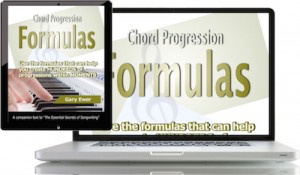If your song is in a major key, you know that the ii-chord is going to be minor. So if your song is in the key of C major, the chord based on the note D will be Dm (D-F-A). And you’ll be using progressions that might be like the following:
- C F Dm G C
- C Dm G Am
- Am F Dm G7 C
If you’re looking for a way to branch out and come up with chord progressions that are a little more creative rather than randomly throwing in chords that come from other keys (an improvisatory process that can take a long time to give good results), you might try:
- choosing one of the chords from a basic progression, and then…
- keeping the root the same, but changing the quality of the chord (change a major chord to a minor one, let’s say) built on that note.
That’s what’s going on when you substitute the F chord (IV), using Fm (iv) instead. That kind of substitution is called a modal mixture, or a borrowed chord, because the Fm comes from the minor key of C minor. So in that sense, we’re borrowing Fm from the key of C minor.
 Looking for ways to create dozens of progressions quickly? Read through “Chord Progression Formulas.” They’ll give you the formulas that will help you come up with lots of progressions within moments. Get it separately, or as part of “The Essential Secrets of Songwriting 10-eBook Bundle”
Looking for ways to create dozens of progressions quickly? Read through “Chord Progression Formulas.” They’ll give you the formulas that will help you come up with lots of progressions within moments. Get it separately, or as part of “The Essential Secrets of Songwriting 10-eBook Bundle”
There are other chords you can borrow, and one that’s related to that minor iv-chord is the diminished-ii chord. Here’s how it works.
As you hopefully know, take any note that comes from the scale of the major key you’ve chosen, build a 1-3-5 triad on that note, and you’ve got the chord that lives naturally in that key. That means that in C major, the tonic triad — also called the I-chord — is C-E-G. A triad on D is the ii-chord, D-F-A. A triad on E will give us the iii-chord, E-G-B, and so on.
That ii-chord (D-F-A) is minor. It’s minor because minor triads are created by forming a perfect fifth (D to A) and then inserting a minor 3rd above the root (D-F).
But if you change that A to Ab, you get this triad: D-F-Ab. That triad is a diminished triad, because diminished triads are created by forming a diminished fifth (D to Ab) and then inserting a minor 3rd above the root (D-F).
How to Use the Diminished-ii-Chord
You’ll be pleased to know that the diminished-ii chord (iiº) can be used practically anywhere a minor ii-chord might be used. So if you look at those 3 sample progressions near the start of this post and change the Dm chords to Dº, you’ll get these:
- C F Dº G C
- C Dº G Am
- Am F Dº G7 C
Earlier I said that the Dº is closely related to the minor iv-chord. Here’s how: In C major, the minor iv-chord uses the notes F-Ab-C. The iiº uses two of those notes, the F and Ab. In fact, playing the iv-chord but using D as your bass note will give you iiº7: D-F-Ab-C.
So the iiº in those 3 progressions above will also sound great when you use the minor iv-chord instead (C F Fm G C).
It’s not an overly-used chord in pop genres. It was quite popular in slower ballads, like “Afterglow” by Genesis, the intro for which used the progression G Gmaj7 C Aº G… an Aº when we were expecting Am.
The best way to be sure you’re using it in a way that makes tonal sense is to write out some standard major key progressions, and then replace any ii-chord or IV-chord with iiº.
 Written by Gary Ewer. Follow Gary on Twitter
Written by Gary Ewer. Follow Gary on Twitter
 “How to Harmonize a Melody” shows you the steps to adding chords to that melody you’ve just come up with. With sound samples to help you understand the concepts.
“How to Harmonize a Melody” shows you the steps to adding chords to that melody you’ve just come up with. With sound samples to help you understand the concepts.











I like your posts, Gary.
I have been a songwriter for decades, and your posts have excellent content. Much better than most that I have seen.
http://www.reverbnation.com/glenngalen
Thanks Glenn!
-G